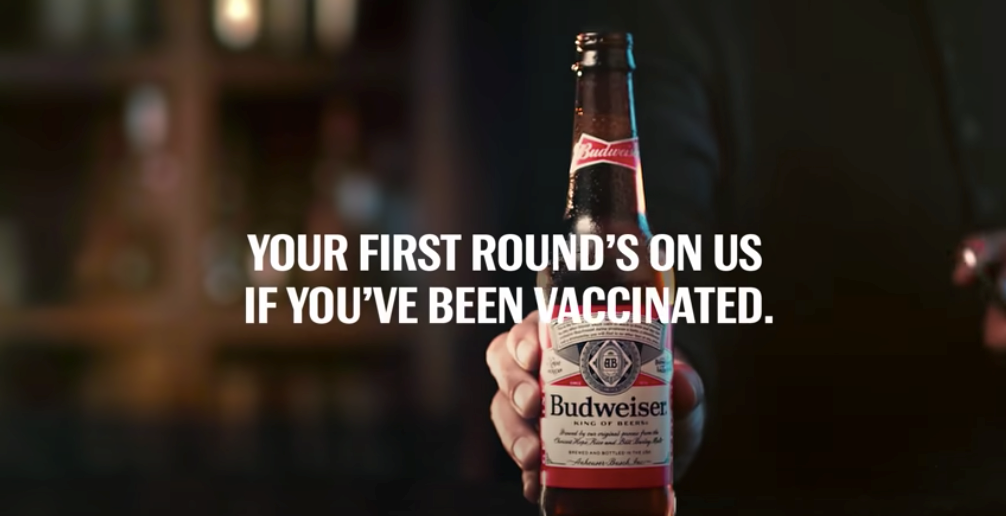Marketers must show consumers that they understand and care about them during the transition back to in-person life after the COVID-19 pandemic and demonstrate that consumers’ well-being is more important to them than profit, according to OBERLAND’s Sarah Kasarsky.
As COVID-19 vaccines become available to all adults across the US, brands have seized the public health milestone by reminding consumers of the joys of in-person experiences. From Budweiser reminding us of the simple pleasures of reuniting with friends (and offering a free round to the vaccinated), to the lip and skincare brand EOS celebrating the in-person obligations we used to hate, brands have equated the return to an “in-person lifestyle” with feelings of pure joy and immense ease.

While, yes, we’re all looking forward to drinking with friends and putting on our “real” clothes, the transition may not be as simple as searching in the closet for that favorite shirt. The truth is that the ease with which these ads depict the return to in-person activities ignores the anxiety, loneliness, anger, stress and worry that has dominated the American psyche over the past year. According to OBERLAND research, in May 2020, 83% of Americans felt more stressed since the start of COVID-19 and eight months later, in January 2021, this overwhelming strain on mental health had not at all subsided, according to the American Psychological Association. In the USA, this burden goes well beyond COVID-19, to include the mental strife of racism, and political and social unrest that has compounded the global pandemic here. More than three in four (77%) Americans cite the future of America as a stressor, and when it comes to racism, a majority of Americans (59%), regardless of race, report police violence toward minorities as a significant source of stress in their lives. This is underscored by new OBERLAND research of 500 US consumers; it found that in the immediate days following the killing of a Black individual by police officers, nearly two thirds of Black Americans say their mental health worsens.
This never-ending anxiety has boiled over into worry about returning to in-person life itself, with more than half of Americans admitting they are anxious about re-adjusting to their in-person lifestyles, according to additional research from the APA. So, as Americans return to their public lives, it will not be with the ease and joy that these ads depict. It will be with the weight of the mental health burdens acquired over the past year, compounded by new psychological traumas formed each day concerning social and political issues like racial injustice and voter suppression that remain front and center in American society.
Brands and marketers must realize that as Americans return to socialization, they will find the return to in-person life – although exciting – scary, uncomfortable and nerve-wracking. How can marketers accomplish this? First, by simply acknowledging the awkwardness and discomfort that will accompany the first hug, the first in-person conversation about Black Lives Matter, or the first date. This can come to life in advertisements or content that authentically depict these anxieties.
The “Post-COVID Dating” skit from Saturday Night Live featuring Nick Jonas and Kate McKinnon is a great example. While satirical, the characters’ awkwardness shows that no one is alone in feeling like they’ve forgotten how to interact with others. This approach normalizes anxiety and stress, helping Americans better cope because they know that what they are feeling is normal.
Marketers can also play a role in helping consumers through key, anxiety-inducing milestones in the transition back to public life, such as returning to work. Soon-to-be-released research from OBERLAND found that employed Americans are most concerned about getting sick or contracting COVID-19 from co-workers. Brands can help ease these concerns by reminding consumers of how they can keep themselves extra-safe from infection. This can live as infographics on social media reminding vaccinated people that they are safe from infection at small outdoor gatherings or when engaging in distant outdoor activities without a mask, per the latest safety guidelines from the Centers for Disease Control, or even repurposed statistics from the CDC to reiterate the efficacy of vaccines. In this role, marketers are simply providing comfort and reassurance to consumers as they embark on triggering milestones.
It’s also important for marketers to adjust communications to audiences of different demographics and ethnicities to account for the specific mental health challenges they are facing, by staying abreast of the news to ensure campaigns and outreach are timely and appropriate; marketing a product or service to BIPOC audiences following a racially-motivated attack will be perceived not only as unimportant, but insensitive. Being mindful of when and how you engage with BIPOC audiences will show these consumers that you prioritize their mental well-being over profit. For example, M+R, a communications organization known for its activism, postponed a webinar announcing its 2021 benchmarks when it became clear it would conflict with the announcement of the Derek Chauvin verdict.
The key ingredient? Empathy. Marketers must show consumers that they understand and care about them during this transition back to in-person life. They must demonstrate that consumers’ well-being is more important to them than profit. And ultimately, marketers will benefit: 86% of consumers say empathy is critical to driving brand loyalty. And with greater loyalty, presumably, comes greater profit.

